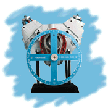

Information to Degree Camshaft
| Engine Rebuild Kit and Parts Online Catalog |

RPM - Ron's Precision Machine, Inc.


|
This page will give you instructions on how to degree-in your new camshaft, and just what a camshaft does. First off , it is very important to choose the right cam for your engine if you are not going to use the stock cam. Cams range in lift and duration (the amount of time the valve is open) to degrees of overlap, and centerline. Lift is the amount of rise on the camshaft lobe, and must be taken into consideration if a higher lift than stock is going to be your choice. Piston to valve clearance must be checked with higher lift cams, especially if a bigger valve is going into your cylinder heads. Overlap is the amount in degrees that both exhaust valve and intake valve are open at the same time. Duration begins after the lifter has traveled around the base circle of the cam and starts to open (in a particular degrees in relation to top dead center) the valve, then rises to full lift, then down the back side of the cam lobe to the back side of the heel where there is no lift again, at which point (in degrees) is the duration of the camshaft. Most cam profiles though are really measured at .020 lift, or .050 lift to really compare one cam to another. Centerline of a cam is a much more complex subject. But the easiest way to degree in a camshaft, is by the centerline process off of the intake valve centerline. Also in degrees. To degree in your cam:
Find true top dead center. Make sure your pointer is pointing at "0" at true top dead center. This is when #1 piston is at top dead center. A dial indicator or a positive stop can be used to find true top dead center. If a dial indicator is used, then just turn engine over, with dial indicator on top of piston, and go .050 of an inch in both directions. Half way in between is true top dead center. We usually use a piece of wire or coat hanger for a pointer, so we can move the pointer one way or the other to get half way between. Be sure and check your pointer by going both directions again .050". Both readings on dial indicator should read exactly the same on your degree wheel. Place dial indicator on #1 intake lifter. Turn engine over until the lifter is at maximum rise. Turn engine over both directions .050" as read on your dial indicator and note where the pointer is pointing on degree wheel. Both directions. Half way between the two is where your degreed in at by centerline off intake valve. If your cam was ground in at say, 110 centerline, then that is where your reading should have been if you installed your cam in at "0". However, some cams are ground 4 degrees advanced; therefore, your reading could have been 106 centerline, and still would be installed at "0". Your cam can also be degreed in using the intake opening point and closing point method, (in degrees) along with degreeing in, or at least checking, the exhaust valve degrees in the same manor. |
|
RPM - RON'S PRECISION MACHINE, INC. Call toll free 1-866-700-5877 or click |